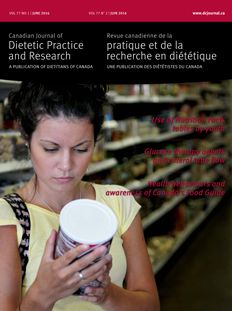Abstract
Purpose: To describe dietary intake associated with intentional weight gain among grade 7 students.
Methods: Data were collected using the Waterloo web-based Eating Behaviour Questionnaire (WEB-Q) and measured heights/weights were taken to assess Body Mass Index (BMI). Dietary intake and the Canadian Healthy Eating Index-2009 were compared among participants who ate more to gain weight.
Results: Among 1015 participants, approximately 9% of participants were actively attempting to gain weight with more males than females (P < 0.001) and more underweight and normal weight than overweight/obese (P < 0.001) participants. Unadjusted analyses revealed that weight gainers versus non-weight gainers consumed more grain products (P < 0.001), meat and alternatives (P = 0.005), and other foods (P < 0.001), in addition to more total energy (P < 0.001). Although greater amounts of carbohydrates, fat, and protein were consumed among the weight gainers, no differences in the percentage of each macronutrient were observed once corrected for total energy intake. The adjusted model revealed that weight gainers were more likely to consume grain products in line with current recommendations, yet they were further from the recommendations for total fat intake.
Conclusion: Health promotion strategies need to consider intentional weight gain among young adolescents to ensure that appropriate weight gaining strategies are being followed to avoid potential detrimental health effects.
Résumé
Objectif. Décrire l’apport alimentaire associé à un gain de poids intentionnel chez des élèves de 7e année.
Méthodes. Les données ont été recueillies au moyen du questionnaire en ligne sur les comportements alimentaires de l’Université de Waterloo (WEB-Q), et les poids et tailles mesurés ont servi à évaluer l’indice de masse corporel (IMC). Une comparaison a été faite entre l’apport alimentaire et l’indice de saine alimentation pour le Canada (Healthy Eating Index-2009) chez les participants qui mangeaient plus pour prendre du poids.
Résultats. Parmi les 1015 participants, environ 9 % tentaient activement de prendre du poids, parmi lesquels on comptait plus de garçons que de filles (P < 0,001) et plus de participants ayant une insuffisance pondérale ou un poids normal que de participants en excès de poids ou obèses (P < 0,001). À la lumière des analyses non ajustées, les participants qui ont pris du poids par rapport à ceux qui n’en ont pas pris consommaient plus de produits céréaliers (P < 0,001), de viandes et substituts (P = 0,005) et d’autres aliments (P < 0,001), en plus d’avoir un apport énergétique plus important (P < 0,001). Bien que de plus grandes quantités de glucides, de gras et de protéines aient été consommées parmi les participants qui ont pris du poids, on n’a constaté aucune différence quant au pourcentage de chaque macronutriment une fois les analyses corrigées selon l’apport énergétique total. Selon le modèle ajusté, les participants qui ont pris du poids étaient plus susceptibles de consommer des produits céréaliers selon les recommandations actuelles, tout en étant loin des recommandations pour ce qui est de l’apport total en gras.
Conclusion. Dans le cadre des stratégies de promotion de la santé, on doit tenir compte du gain de poids intentionnel chez les jeunes adolescents afin que les bonnes stratégies de prise de poids soient adoptées et d’éviter d’éventuels effets nuisibles sur la santé.



